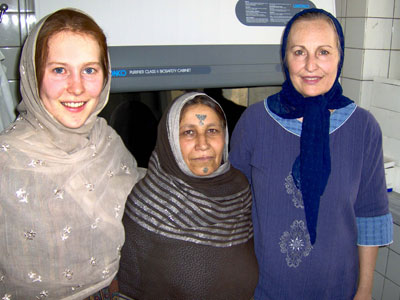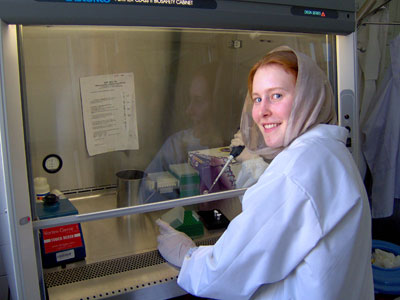When Grace Eckhoff went to Afghanistan last summer to study multi-drug resistant tuberculosis (MDR-TB) infection rates, it was a kind of return to her childhood.
Eckhoff, a Dean's Scholars Honors Biology major and Plan II Honors major, grew up in Haiti, where her parents were doctors at a small hospital. While her parents were working, she'd often pass the time playing with the kids in the chronic illness ward, most of whom had tuberculosis. They were being treated there, rather than at home, precisely to preempt the development of drug resistant strains of tuberculosis.
"In Haiti, there tends to be a sharing mentality about medication," says Eckhoff. "If someone in the family has a cough, they might end up using the antibiotics for the TB, and then the child doesn't complete the treatment. When that happens, resistances have more of an opportunity to develop. So instead of being treated at home, children would come to the hospital for six to eight months so that they'd be sure to complete the treatment."
When Eckhoff's parents moved to Afghanistan in 2005, she decided to defer her first year of college and go with them. She worked as a teachers' aide, took language lessons in Dari—the language of the Balkh province where her parents were living—and helped to found a bilingual kindergarten.
When the time came last year for her to devise a topic for her honors research thesis, she knew she wanted to do something that would take her to Afghanistan. She also wanted, if possible, to do a project that would draw on what she'd learned as a student in the College of Natural Sciences Freshman Research Initiative (FRI) in the laboratory of biochemist Andy Ellington.
"I had two criteria," she says. "It had to be feasible for me to do on my own, and I wanted it to be useful and pertinent to the situation there."
After getting the lay of the land in Afghanistan and reading widely in the medical literature that dealt with the developing world, Eckhoff discovered a gap in the country's public health system she might be able to help fill. Although the country's National Tuberculosis Program was doing an excellent job locating and treating outbreaks of the disease, it didn't have the resources to test specifically for evidence of MDR-TB strains.
The problem, says Eckhoff, was that while it's safe and quick to test for TB, the traditional method for testing for MDR-TB is slow and dangerous. It involves culturing the tuberculosis bacteria for weeks, and it poses serious risks of infection to the tester unless a lot of safeguards are in place. In developing countries like Afghanistan, it's easier for doctors to just prescribe the standard antibiotics. If that treatment doesn't work after a few months, doctors assume the patient is infected with a resistant strain and will then prescribe a course of different antibiotics.
Such an approach, says Eckhoff, typically works out well enough for the individual patients. It leaves the patient contagious for longer, however, which leads to more infections, and it can result in a systemic over-prescription of antibiotics, which can lead to more resistance.
What Eckhoff had discovered while researching the topic was that more and more public health workers in the developing world—faced with similar kinds of constraints—had been field testing a new method (PDF) for identifying MDR-TB. Rather than culturing the bacteria, and looking through a microscope at what grew, they were extracting DNA from each sample, and looking for genetic signatures of drug resistance.

This was, as it turned out, precisely the kind of extraction and analysis Eckhoff had been trained to do as a researcher in Ellington's lab. She already knew how to do the work of extracting small pieces of DNA and then replicating them enough to allow for analysis—a technique known as polymerase chain reaction (PCR). The hard part would be acquiring a large enough sample from the pool of TB infections in Afghanistan for the results to be significant, and also doing the DNA extraction in conditions that were less than ideal.
"Grace's unique and amazing ability," says Ellington, who was an adviser on the project, "is to be able to understand the rather deep science involved in antibiotic resistance, and to transition it to a place I can't imagine even visiting."
If Eckhoff could manage to collect a representative sample of the tuberculosis bacteria going around Afghanistan, and if she could identify what percentage of them had evolved drug resistance, she could paint the government a relatively good picture—its first—of how significant a problem MDR-TB was.
After a considerable amount of coordination and bureaucratic wrangling, Eckhoff was able to secure a spot last summer in the Naval Academy Medical Research Unit lab in Kabul. She lived with her mother and commuted every day to the lab, which was in the Afghan National Army Hospital.
Working with the Afghan Ministry of Public Health and the country's National Tuberculosis Program, Eckhoff took advantage of the already existing quality assurance system in order to collect samples of sputum from TB-infected patients from around the country.
"At each clinic or hospital where they test for TB," she says, "every technician routinely sends a sample of his work, of both positive and negative results, to a provincial laboratory. There, another technician tests the sample and compares the results to see if they agree. Samples are then forwarded to the central lab in the province. Normally, at that point, they would be used for demonstrations and then thrown away. But I was able to coordinate with the central lab in Kabul, and instead of throwing them away, the central lab technicians from each of the provinces kept them and gave them to me when they came to Kabul for their annual conference."
Working in the lab in Kabul, she extracted DNA from more than 500 samples from around the country. She brought the samples, which represented five percent of the cases from each region, back to Austin in the fall, and has been analyzing them in Ellington's lab since then.
What she's been looking for, in particular, is evidence of resistance to rifampin, one of the two antibiotics most commonly used to treat tuberculosis.
"Resistance to rifampin is confined to one gene, and 96 percent of resistant bacteria have a mutation in that one gene," says Eckhoff. "It's been a very popular target for genotypic resistance testing for that reason. Technically, when we refer to MDR-TB, what that means is that a particular strain is resistant to both isoniazid and rifampin, but because isoniazid was historically used much more than rifampin, whenever a strain is resistant to rifampin it's almost always resistant to isoniazid as well."

Eckhoff's results, when they're complete, should provide the basic information the Afghan government needs in to determine the proper public health strategy to adopt. If she doesn't end up finding much MDR-TB, it may not be worth committing the resources to equip a lab to test for drug resistant TB on a case-by-case basis. If she finds high levels of resistance, it could end up helping to save lives.
"In order to make those cost-benefit considerations," she says, "they need some sort of numbers about how many cases there are. That's where I see my project coming in. I'm providing information about a base level of resistance."
Once her first results are collected and analyzed, Eckhoff may continue on with the project. She's considered deepening her analysis of the samples, comparing the strains and their regional distribution to what's already known about strains from neighboring countries. Such a comparison could begin to illuminate how the disease has spread into and throughout the country.
"Growing up in Haiti, I saw how great the need was for better public health," says Eckhoff. "There are so many simple, simple things that can be done, like providing cleaner drinking water and better nutrition, that can have profound effects on mortality and quality of life."
Eckhoff, who will graduate in May of 2010, is spending 10 weeks this summer as an intern at the Pasteur Institute in Paris. She'll be looking at the connections between a recently discovered family of human enzymes and cancer-causing mutations. Beyond that point, she's not sure, though she's leaning toward medical school.
"At some point, I'd love to go back to Afghanistan," she says. "I loved being there. The future there, however, is so uncertain. I don't know if it'll be a possibility in five or 10 years. Whatever I do, though, research will be a part of it."


















Comments